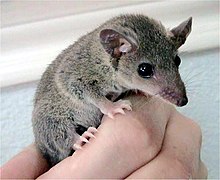Short-tailed opossum
| Short-tailed opossums | |
|---|---|

| |
| Gray short-tailed opossum (Monodelphis domestica) | |
| Scientific classification | |
| Domain: | Eukaryota |
| Kingdom: | Animalia |
| Phylum: | Chordata |
| Class: | Mammalia |
| Infraclass: | Marsupialia |
| Order: | Didelphimorphia |
| Family: | Didelphidae |
| Tribe: | Marmosini |
| Genus: | Monodelphis Burnett, 1830 |
| Type species | |
| Monodelphis brachyura | |
| Species | |
|
see text | |
Monodelphis is a genus of marsupials in the family Didelphidae, commonly referred to as short-tailed opossums. They are found throughout South America. As of January 2019[update], the most recently described species is M. vossi.[1]
Species
[edit]| Cladogram of living Monodelphis[2][3] | |||||||||||||||||||||
|
- Sepia short-tailed opossum (Monodelphis adusta)
- Northern three-striped opossum (Monodelphis americana)
- Arlindo's short-tailed opossum (Monodelphis arlindoi)
- Northern red-sided opossum (Monodelphis brevicaudata)
- Yellow-sided opossum (Monodelphis dimidiata)
- Gray short-tailed opossum (Monodelphis domestica)
- Emilia's short-tailed opossum (Monodelphis emiliae)
- Gardner's short-tailed opossum (Monodelphis gardneri)
- Amazonian red-sided opossum (Monodelphis glirina)
- Handley's short-tailed opossum (Monodelphis handleyi)
- Ihering's three-striped opossum (Monodelphis iheringi)
- Pygmy short-tailed opossum (Monodelphis kunsi)
- Osgood's short-tailed opossum (Monodelphis osgoodi)
- Hooded red-sided opossum (Monodelphis palliolata)
- Peruvian short-tailed opossum (Monodelphis peruviana)
- Long-nosed short-tailed opossum (Monodelphis pinocchio)
- Reig's opossum (Monodelphis reigi)
- Ronald's opossum (Monodelphis ronaldi)
- Saci short-tailed opossum (Monodelphis saci)
- Santa Rosa short-tailed opossum (Monodelphis sanctaerosae)
- Long-nosed short-tailed opossum (Monodelphis scalops)
- Touan short-tailed opossum (Monodelphis touan)
- One-striped opossum (Monodelphis unistriata)
- Voss's short-tailed opossum (Monodelphis vossi)[1]
Species limits are based on fur coloration with additional details coming from differences in the skull and teeth.[4]
Behavior
[edit]Short-tailed opossums show a rich repertoire of stereotyped behaviors.[5] Postures, locomotion, and grooming behaviours are similar to those of other didelphids. They also can carry nest materials using their short prehensile tails.[5]
Short-tailed opossums show specialized behaviors for dealing with challenging prey.[5] For example, attacks and initial consumption of large insects are initially directed to the insect's head, hairy caterpillars are scratched to get rid of the urticating hairs, and mice are attacked using a throat clamp technique.[5]
Chemosensory communication
[edit]Short-tailed opossums have been found to use nuzzling in chemosensory and exploratory behavior for recognizing individuals of the same species. In Monodelphis domestica, nuzzling and snout-rubbing transforms odor from dry components like glandular secretions, feces, and urine, into moist naso-oral secretions that reach the vomeronasal organ to be processed chemically. Typically, this behavior is used to recognize individual familiar or new scents from the same species, with males typically being drawn to more novel scents from the same species.[6]
Reproduction
[edit]The genus Monodelphis is marsupial; they are born under-developed and then mature further in the mother's pouch. In Monodelphis, the young first come off the teat in 12 days, whereas this occurs at 48 days in the related genus Didelphis. Most of the events in this process occur about 2–4 weeks later in Didelphis than in Monodelphis. This may be related to the shorter longevity of the species of Monodelphis compared to other marsupials who nurse for a longer period.[7] M. dimidiata is unusual in that it is a semelparous species, something rarely seen in mammals, being found predominantly in smaller didelphids and dasyurids.
References
[edit]- ^ a b Pavan, Silvia E (11 January 2019). "A revision of the Monodelphis glirina group (Didelphidae: Marmosini), with a description of a new species from Roraima, Brazil". Journal of Mammalogy. 100 (1): 103–117. doi:10.1093/jmammal/gyy165.
- ^ Upham, Nathan S.; Esselstyn, Jacob A.; Jetz, Walter (2019). "Inferring the mammal tree: Species-level sets of phylogenies for questions in ecology, evolution and conservation". PLOS Biol. 17 (12): e3000494. doi:10.1371/journal.pbio.3000494. PMC 6892540. PMID 31800571.
- ^ Amador, Lucila I.; Giannini, Norberto P. (1 September 2016). "Phylogeny and evolution of body mass in didelphid marsupials (Marsupialia: Didelphimorphia: Didelphidae)". Organisms Diversity & Evolution. 16 (3): 641–657. Bibcode:2016ODivE..16..641A. doi:10.1007/s13127-015-0259-x. hdl:11336/50679. S2CID 17393886.
- ^ Solari, Sergio (2010). "A molecular perspective on the diversification of short-tailed opossums (Monodelphis: Didelphidae)". Mastozoología Neotropical. 17 (2): 317–333.
- ^ a b c d González, E.M.; Claramunt, S. (2000). "Behaviors of captive short-tailed opossums, Monodelphis dimidiata (Wagner, 1847) (Didelphimorphia, Didelphidae)". Mammalia. 64 (3): 271–286. doi:10.1515/mamm.2000.64.3.271.
- ^ Poran, Naomie S.; Tripoli, Robin; Halpern, Mimi (1993). "Nuzzling in the gray short-tailed opossum II: Familiarity and individual recognition". Physiology & Behavior. 53 (5): 969–973. doi:10.1016/0031-9384(93)90276-l. ISSN 0031-9384. PMID 8511214. S2CID 38881374.
- ^ Smith, Kathleen K.; van Nievelt, Alexander F. H. (31 January 1997). "Comparative Rates of Development in Monodelphis and Didelphis". Science. 275 (5300): 683–684. doi:10.1126/science.275.5300.683. PMID 9005857. S2CID 34138665.
Further reading
[edit]- Castilheiro, Welvis Felipe Fernandes; Santos Filho, Manoel dos (June 2013). "Diet of Monodelphis glirina (Mammalia: Didelphidae) in forest fragments in southern Amazon". Zoologia (Curitiba). 30 (3): 249–254. doi:10.1590/S1984-46702013000300001.
- González, E. M.; Claramunt, S. (1 January 2000). "Behaviors of captive short-tailed Opossums, Monodelphis dimidiata (Wagner, 1847) (Didelphimorphia, Didelphidae)". Mammalia. 64 (3): 271–286. doi:10.1515/mamm.2000.64.3.271. S2CID 84782113.
- Know Your Short-tailed Opossum: Monodelphis
- Integrated Taxonomic Information System
- Gardner, A.L. (2005). "Order Didelphimorphia". In Wilson, D.E.; Reeder, D.M (eds.). Mammal Species of the World: A Taxonomic and Geographic Reference (3rd ed.). Johns Hopkins University Press. pp. 13–16. ISBN 978-0-8018-8221-0. OCLC 62265494.
